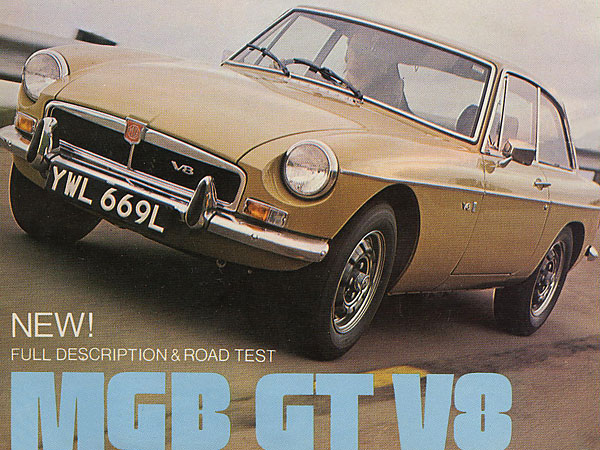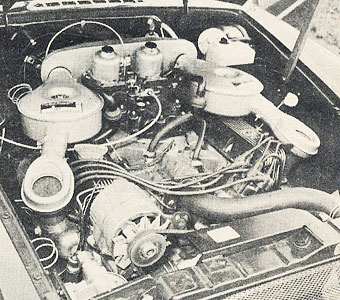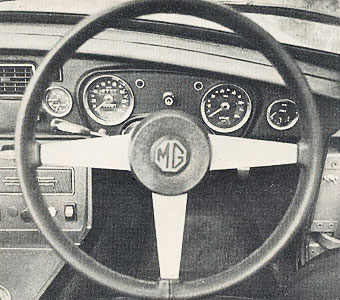�

�
The body of the MGB GT V8 sits noticeably higher off the road than the normal MGB GT although
�
ground clearance is reduced by 1/2" by the larger diameter exhaust system required by the V8
�
engine. V8 insignia are used on the radiator grille, the nearside front wing, and on the tailgate.
�
The only other obvious external means of identification are the Dunlop wheels.... [which have]
�
cast aluminium centres rivetted to chromed steel rims. �
Look What's Gone Into The MGB GT V8
�Superb Rover V8 in a B - at last
��
as published in British V8 Magazine, Volume XVI Issue 1, May 2008�
�
Re-printed unedited by exclusive written permission of "Autocar" weekly magazine.
�
This article originally appeared in the issue for the week ending August 16, 1973.�
�
by A.D. Shanks
�
drawing by Dick Ellis
�
�
British Leyland have now introduced the long awaited V8-engined MGB. Unfortunately,�
the new car will only be available in GT form, and as such, it has stepped into a very�
competitive sector of the market. The installation is well engineered, and takes account�
of all immediate European emissions regulations. As the all-aluminum V8 weighes only �
slightly more than the B-series four cylinder engine, the balance is not seriously affected. �
�
Following the demise of the MGC, British Leyland have re-assessed the available power units �
and decided that the timeless MGB would combine well with the aluminum Rover V8 engine from �
the 3500 range. To effect this metamorphosis of the MGB, much work has been involved to �
shoehorn the wide V8 engine into the narrow engine bay of the B, which up to now, has been �
plenty wide enough for the in-line fours and sixes that have been used.�
�

�
The cutaway diagram reveals the tight fit of the Rover V8 engine. The temperature-sensitive hot/cold air blending
�
valves can be seen forward of the air-cleaner cans. The external oil cooler and oil filter are shown, as are the
�
thermostatically controlled electric cooling fans, with their protective wire mesh cover... �
�

�
Also evident is the very short propeller shaft that contributes much to the
�
smoothness and lack of vibration in the driveline.�
�
To make sufficient room for the Rover engine, both the inner wheel arches and the engine �
bulkhead have been changed in shape, and by setting the engine well back in the bay, it �
has been possible to retain a near 50/50 weight distribution (50.7/49.3). In order to �
rationalize, some of the changes that have been made to allow the V8 installation will be�
introduced on all MGBs, principally because the opportunity has been taken with the MGB �
V8 to change the datum points of the suspension pickups to gain a better bumper height. �
It is immediatly noticeable that the V8 stands higher off the road than previous MGBs, �
the height difference being 1 inch.�
�
The variation of the Rover 3528cc V8 used has most in common with that used in the Range Rover,�
sharing the same dished pistons which give a compression ratio of only 8.25 to 1. The Rover �
engine is well known in its application in the Rover 3.5 litre as well as in the 3500 and �
Range Rover, but its suitability in a high performance application has already been well �
proven in the popular 3500S. Oversquare dimensions and a very sturdy bottom-end permit the �
engine to retain its smoothness beyond its power peak at 5000 rpm up to the onset of "pumping �
up" of the hydraulic tappets. In order to allow the use of the standard MGB bonnet, it has �
been necessary to use different inlet manifolding to that employed on either the Rover �
3500 or the Range Rover. Instead of mounting the twin carburettors on the top of a penthouse �
manifold, the MGB application moves the carburttors toward the back of the engine, with �
forward facing inlet tracts into a plenumb chamber approximately in the center of the vee. �
In addition to meeting the requirements for bonnet height, this arrangement gives a slight �
increase in low-speed torque.�
�
The engine has been developeed to meet the ECE 15 European Emission Regulations and to enable �
it to do this, neat temperature-sensitive bimetallic valves have been built into the air intakes�
and are arranged to draw in warm air from sleeves on the exhaust manifolds when occasion �
demands. The extremely low compression ratio enables the car to run on 97 octane (RON), 4-star �
petrol. The carburettors are the SU HIF6 (horizontal integral float chamber) type as fitted to �
the Rover 3500S. A change from the specification of the Rover 3500 is the use of an AC Delco �
alternator as opposed to the Lucas unit.�
�
The maximum power of the engine as installed in the MGB V8 is 137 bhp (DIN) at 5000 rpm, �
while maximum torque is 193 lb./ft. at 2900 rpm, compared with 150 bhp and 204 lb.ft for �
the Rover 3500S, and 130 bhp and 185 lp/ft for the Range Rover. �
�
The gearbox is a modified version of that first seen in the MGC, and now fitted as standard�
on 4 cylinder MGBs. It has synchromesh on all forward gears and internal ratios of �
3.138 (1st), 1.974 (2nd), 1.259 (3rd), top gear is direct. Overdrive is fitted as standard, �
working on top gear only, and has a ratio of 0.820. The gearbox casing has had to be �
changed from that of the 4 cylinder car, as a larger clutch (9.5" as opposed to 8") is �
required to cope with an increase in torque of 75 per cent over the 4 cylinder engine.�
The clutch has a ballrace withdrawal race as opposed to the carbon ring of the MGB. �
�
 �
�

�
Left: The all-aluminium Rover 3528cc V8 engine is a snug fit in the engine bay, although routine service items are kept in
�
reach. The new inlet manifold that allows the rearward positioning of the carburettors can be seen. Right: The left-hand
�
fingertip stalk now controls the overdrive, as well as the windscreen wiping and washing. The necessary larger shroud
�
intrudes further into the base of the fascia, requiring the use of a smaller-sized speedometer and rev counter.�
�
Enjoying this article? Our magazine is funded through the generous support of readers like you!
�
To contribute to our operating budget, please click here and follow the instructions.
�
(Suggested contribution is twenty bucks per year. Feel free to give more!)�
�
The changes to the suspension are minor, and are to control the increase in torque, rather�
than to have any effect on handling and ride. The spring rates are 102 lb/in at the front �
and 115 lb/in at the rear as opposed to 100 and 105 lb/in respectively on the MGB 4 cylinder.�
It eas not found necessary to change either the damper settings or anti-roll bar stiffness, �
both being as for the MGB.�
�
The most obvious external identification of the V8 car are the Dunlop wheels, which have �
ventilated cast alloy centres rivetted to chrome steel rims. These wheels are immensely�
strong, the life acceptance standards being easily exceeded on rig tests. �
�
To cope with the increased cooling requirements of the V8 engine, the MGB V8 is fitted with �
a larger radiator than the 4 cylinder car, and twin thermostatically-controlled electric �
fans are used to reduce noise and power absorption. An oil cooler is fitted as standard, �
as opposed to being an optional extra as on the MGB.�
�
Inside the car, there are few changes from the normal MGB. The adoption of the American-market �
column switchgear has meant that a smaller speedometer and rev counter have had to be used,�
as the shroud of the steering column is larger. The fingertip stalks control the headlights �
on the right hand side, and overdrive, and windscreen washing and wiping on the left hand. �
�
The price for the MGB V8 includes most of the items that were previously available as optional �
equipment on the 4 cylinder car, including overdrive, tinted window glass, heated rear window, �
and a door-mounted outside mirror. The only optional extra on offer is inertia reel seat belts�
which can be specified for factory fitment at £15.85, otherwise the price of £2293.96 �
includes all the equipment detailed in this description.�
� When Autocar originally published this article, they illustrated it with the cutaway drawing � shown above, arranged so it spanned two pages as one large illustration. Part of the original � cutaway drawing was obscured by the binding. Autocar also included four black-and-white photographs. � We included two of the original photographs here, and we have substituted the magazine's cover � photo for the article's two comparitively small, plain photos of the car's exterior. (We combined � the original captions, above.) The car shown in the original black-and-white photos was � light-colored and carried registration plate "YWL 667L".�
��
� BritishV8 Magazine has assembled the largest, most authoritative collection of MG � "MGB GT V8" information you'll find anywhere. Check it out! � Access our � MGB GT V8 article index by clicking here. �
�
